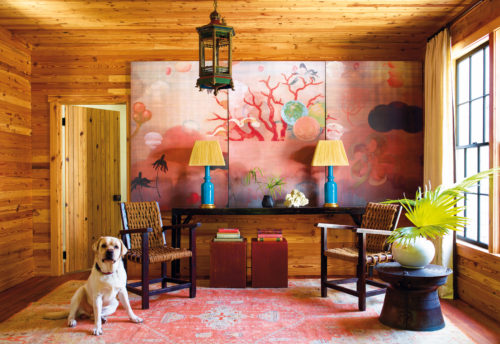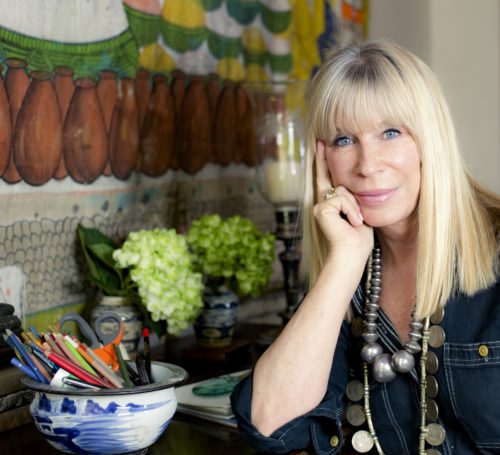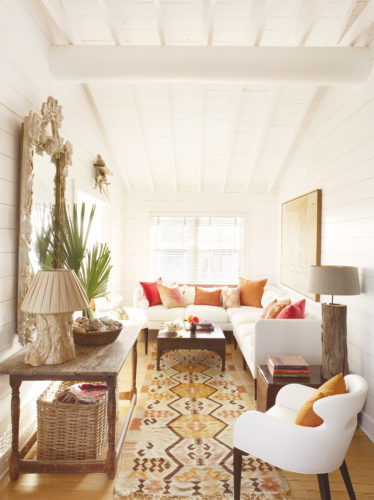
The interiors in this Sullivan’s Island, South Carolina, home take its color cues from the fantastical triptych in the entry. Photo by Eric Piasecki
Q&A
Flower: How has living in such an iconic city affected the way you design?

Amelia Handegan. Photo by Gately Williams
Several of your projects are historic homes. In decorating, do you feel the need to be true to period style?
Absolutely not. I don’t think I have ever done a truly period room. It is not the way people live in the 21st century and it would probably be out of many budgets! I think introducing elements true to the period of the house is important, but it could be something as simple as one painting or a pair of chairs sitting in front of windows.
Amelia Handegan’s playfulness shows through in her personal home. She commissioned a contemporary artist to enhance the 18th-century portrait with Chanel sunglasses and a swimsuit. Photo by Pieter Estersohn
When is it OK to break the rules yet still honor the historic architecture?
It’s always okay to break the rules once you understand the rules. A Victorian house is a good example. During the Victorian period, a house would have been decorated with a heavy hand. Today, I think it’s best to leave the interior almost stark and let the windows and heavy moldings tell its story. When you use restraint, a period home can become a modern living space.Your interiors always incorporate antiques, but there’s no museum stiffness in your projects. How do you warm them up for today’s homes?
I use antiques casually so they don’t come across as too precious. When you take a little bit from everywhere and every period, including mid-century, you can create the storied look of a well-traveled collector. It’s not uncommon for me to mix English Regency, West Indies, and Asian antiques in the same room. If you use everything from one era, a room might be intimidating. You can change the attitude of a room quickly by mixing in something contemporary.
Handegan’s Folly Beach house showcases one of her custom designed sofas and a vintage kilim rug. Plank walls are painted bright white to reflect sunlight. Photo by Pieter Estersohn
Your rooms have a layered, collected look using antiques, fabrics, murals, painted floors, and artifacts. How do you create a cohesive look from so many seemingly disparate parts?
I like to bring together individual items and color that work together as a whole. I want the details to be slowly revealed in a complementary way that is not high contrast. It’s all about balance and harmony.You seem to use a similar approach when it comes to layering color. How does this translate?
I like calm rooms, and I don’t think this has to mean neutrals. For example, a client wanted to use red in her Manhattan piedà- terre. To temper the bold choice and give it dimension, we layered slightly different shades of red. When working with one color, the more variations you use, the better. Sometimes a room could have 30 or more variations, but at a glance it will seem to consist of only two or three.Some of your palettes challenge textbook combinations, yet they are immensely inviting. Any tips for successfully stepping outside the box?
My husband and I have a passion for travel, and I like to study the way colors work together in different cultures. For instance, in Bhutan your eye may see yellow, gold, pink, and a little bit of purple on the walls of a temple and the robes of a Buddhist monk, and they somehow all work together. I look for snapshots of colors that you wouldn’t typically expect and see how they can be translated to interiors. When I was designing my last home, an 1820s Greek Revival house, I could test this theory out because I had no one to please but myself. In the dining room, I used bronze on the walls and an intense pink fabric on the chairs. In an 1890 Sullivan’s Island house, the owner wanted to keep the original pine plank walls. We created our palette from a triptych of oranges, turquoise, and black we found for the entry and used those colors in different measures and strengths throughout the house.With so many layers and dimensions in your designs, how do you know when a project is finished?
Sometimes I have to learn to be finished. Sometimes it’s when the client says we’re finished. I think the ultimate test is when you can walk out of a room, look back, and feel like someone actually lives there. If you can move a glass on the coffee table and it looks like something is missing, you aren’t finished.By Cathy Still McGowin



